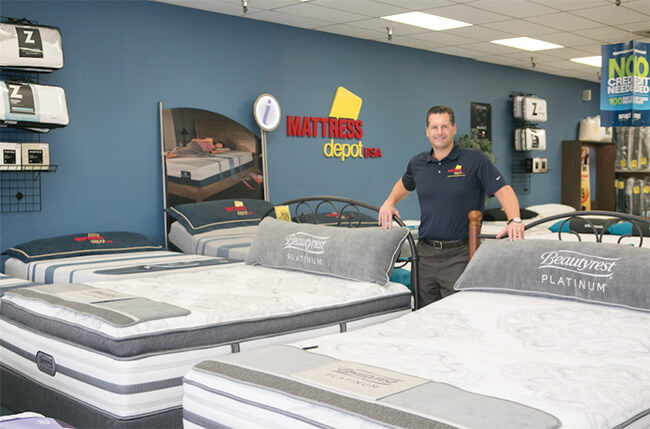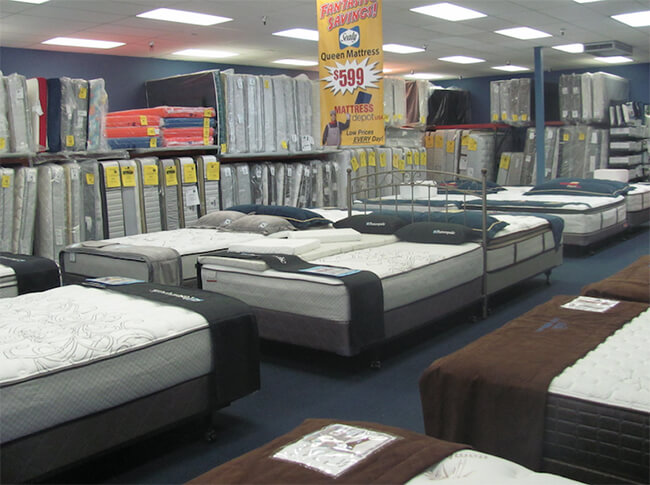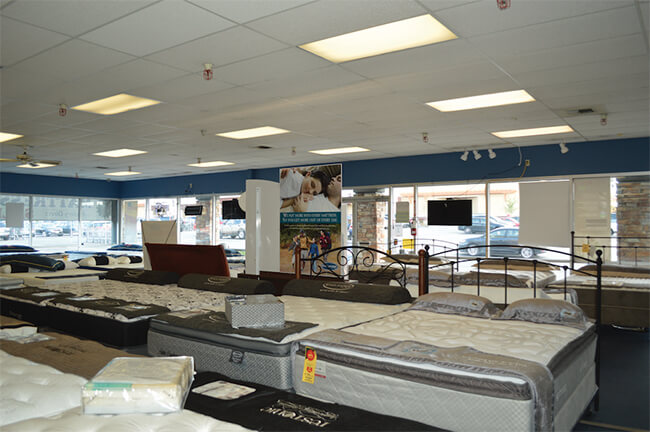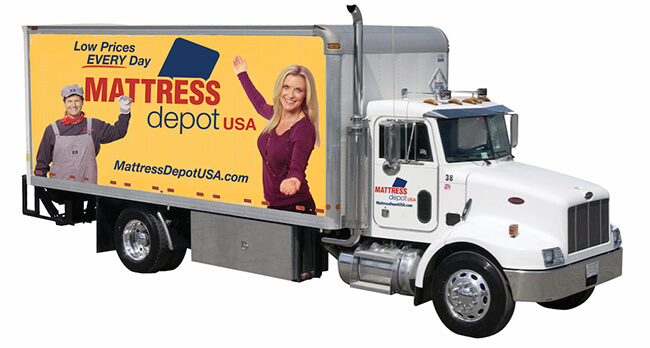A move away from deep discounts and closeouts boosts average tickets, increases sales and spurs store openings for this Bellevue, Washington-based sleep chain Mattress Depot USA.

Once known primarily as a destination for hot deals on factory closeouts and other deeply discounted beds, Mattress Depot USA has gradually morphed into a full-line specialty retailer of high-quality, brand-name mattresses across a range of price points.
While the Bellevue, Washington-based regional chain still offers a few closeout models in its mix, the category now accounts for only 5% to 10% of business. Five years ago, the average sales ticket was just $400 and the retailer’s main brand was Sealy. Today, the average ticket is $800 and climbing—and the product assortment has expanded to include Beautyrest, Emerald Sleep, iComfort, Lady Americana, Malouf, Restonic, Serta and Simmons brands.
The price range for a queen-size mattress set now starts at $349 for Restonic’s Topaz model and runs up to $3,199 for Serta’s iComfort Blue Max 3000. The company also offers an assortment of private-label bedding.
Mattress Depot USA, which ended 2017 with 32 stores in Washington and Oregon (including five franchised units), was founded by Chief Executive Officer David Smith and his wife, Torey, a certified public accountant and chief financial officer of the company. David Smith started his career in 1998 as a commercial banker and, when a friend came to him seeking advice for a mattress store startup in Las Vegas, he ended up investing in the business and becoming a partner. After a few years, Smith sold his interest in that store and joined IBM, working in its finance arm. During his tenure there, Smith worked with top executives at prominent companies such as Costco, Nordstrom, REI and Starbucks. Smith attributes his retail prowess to lessons learned while working with those retailers during his previous career.
Having grown up in the Seattle area, Smith had a good understanding of the market geography and business climate of his home state. So, in 2002, after selling his interest in the Las Vegas store, Smith decided to start a new retail business in Bellevue, an affluent suburb of Seattle.

‘Stack them high’
Smith’s initial location was a warehouse setup where he sold factory seconds on weekends by appointments generated through classified ads. As the business grew, he hired an associate and expanded the warehouse’s hours. In 2003, he opened his first true retail mattress store and then, soon after, added two more stores acquired from a 12-store chain that had gone out of business. The seeds of the Mattress Depot USA chain were planted.
“Back then, our business model focused on excess inventory, closeouts and factory seconds that manufacturers needed to clear out to make room for new models,” Smith says. “Our motto was ‘stack them high and let them fly.’ We would stuff the stores with inventory and try to sell as much as we could on the spot for immediate delivery or pick up by the consumer.”
For many years, Mattress Depot USA thrived with this approach, and its sales and store network steadily grew. But about five years ago, after watching same-store sales growth plateau, the retailer decided to try a new strategy.
“Our same-store sales were stuck in the same range year over year, no matter how much we spent on marketing,” Smith says. “The flow of traffic and business activity were generally constant.”
After studying the numbers, Smith and his team identified an opportunity. “We realized that our average sales ticket was about one-third that of the industry average and that if we could increase the size of each ticket by 10% by selling more accessories, our sales would rise by the same level,” he says.
In the initial stage of its transformation, Mattress Depot USA made no changes to its product mix. “We simply asked our salespeople to suggest an accessory or two with every purchase,” Smith says. “We saw the results pretty quickly, but we soon realized it wasn’t enough. There are only so many protectors and pillows you can try to add on to a mattress sale before the customer gets fatigued.”

Changing the mix
Eventually, Smith decided to explore higher-priced merchandise. “By 2012, the economy was recovering from the Great Recession,” he says. “We started by bringing in a few higher-end closeouts from the three Big S brands (Sealy, Serta and Simmons) and, based on that success, expanded into more nonclearance product from those and other lines. We soon were able to grow our average unit price, as well as the average ticket size.”
It took a while for retail sales associates to gravitate toward selling the pricier models. But, over time, they found customers were much less resistant to spending more than RSAs had feared.
“There’s always going to be a few customers who buy only based on price,” Smith says. “But for many others, there’s a value that comes with buying a recognized brand backed by a full factory warranty. If the features and benefits are there, they’re open to spending more.”
During the past five years, Mattress Depot USA has seen its average sales ticket climb each and every year. In 2017, the company also registered same-store sales growth in the double digits. “Our customers now see us as the place to go for a large selection of high-quality mattresses—not just the lowest price,” Smith says.
To reinforce the message, Mattress Depot USA deploys a mix of television and online advertising. The ads showcase the mattress brands the retailer carries, as well as its assortment of higher-end adjustable bases from BedTech, Leggett & Platt, Malouf, Restonic and Serta.
“We have totally gotten away from price advertising,” Smith says. “We used to promote ourselves as the largest factory-second, clearance and closeout specialist in the region. Now our ads center on our selection of quality brands and knowledgeable, friendly service.”

Ready and waiting
In all its stores, Mattress Depot USA aims to deliver a consistent shopping and purchasing experience. The typical store footprint runs about 3,000 to 4,000 square feet, with room for 30 to 40 accessorized mattress displays. In a nod to the company’s roots, each store also features wall racks that hold neat stacks of mattress models. The racks underscore the “ready for pickup or delivery today” aspect of the retailer’s business model, as do colorful signs hanging from the ceiling and walls.
“Less than 50% of our beds are delivered,” Smith says. “We always have a deep stock of popular models in each of our stores so consumers know they can get the bed they need without having to wait. They like the fact that most of the time we have the bed they want in stock and ready to take home.”
Mattress Depot USA works closely with its vendors to ensure a steady supply of its best-selling models. “It’s been one of our strengths,” Smith says, adding that Lady Americana and Restonic have been particularly adept at providing quick delivery of best-sellers and special orders when needed. “We’ll place an order on Monday and we start to get our orders on Wednesday,” Smith says.
Customer service is another area where Mattress Depot USA works hard to stand out. The retailer offers free same-day delivery of in-stock mattress sets on any minimum purchase made in-store before 2 p.m. The delivery team provides complete setup of the bed and removal of old mattresses, which are recycled through one of three independent facilities located near its stores. The retailer charges $15 per piece for the recycling service.
To give customers peace of mind about their purchases, the retailer offers a 120-day “comfort guarantee” on any mattress sale that includes a protector. Without a protector, the exchange window is 30 days. As a result, Mattress Depot USA’s attachment rate on protectors is 60%.
“We don’t do a hard sell on it,” Smith says. “We simply point out how a protector helps protect your investment and makes the mattress last longer.”
Adjustable bases are another product category with a growing attachment rate. Three years ago, the retailer sold only one adjustable base per store per month. Today, thanks to a round of rigorous in-store training and an expanded product assortment, each Mattress Depot USA store now sells 10 to 15 adjustables each month.
“We just had a record month for adjustables,” Smith says. “Our salespeople are making them a part of every sales conversation. They point out how this feature isn’t just for back problems anymore—it’s something that adds a lot of function to the bed, whether you’re sleeping, reading, working on a laptop or watching TV. And it greatly improves the sleep experience by allowing sleepers to adjust the surface to their individual needs.”

Positioned for growth
While Mattress Depot USA will continue to offer a limited selection of closeout models in a small clearance corner in every store and a “last-chance outlet” on its website, the retailer has eliminated most of that merchandise from its mix during the past year. To manage the change, the company took a hiatus from any store expansion.
“We went through a period of retrenchment as we revamped our vendor list,” Smith says.
The retailer also made some changes to its back office and ordering systems to make product flows more efficient. Recently, it hired Mike Estes, a former regional vice president for Mattress Firm, as its vice president of sales. Estes works with Clint Comer, Mattress Depot USA’s longtime general manager, who was promoted to vice president of operations.
The new management puts Mattress Depot USA in a prime position for growth. “We’re looking to grow again,” says Smith, who opened two new stores—in Lakewood, Washington, and Yakima, Washington—toward the end of 2017. The company expects to add two or three new company-owned stores in Washington this year, along with several franchised stores in California and Oregon.
Right now, Mattress Depot USA is confining its corporate-owned store growth to Washington and using franchisees to grow in California and Oregon. The goal, though, Smith says is “to keep growing into new markets” by adding new franchised and company-owned locations and making strategic acquisitions. “We’re always on the lookout for small mom-and-pop stores that are struggling or ready to retire,” he says.
Chain adding boxed beds in-store and online
The wave of competition from boxed beds sold online is something Mattress Depot USA founder and Chief Executive Officer David Smith is watching closely. While he doesn’t view the trend as a major threat to the Bellevue, Washington-based regional chain, Smith has been making some changes to his stores’ product mixes to ensure that segment of the market doesn’t go unserved.
The biggest change: Smith has asked two key vendors—Lady Americana and Restonic—to make any new mattress models retail priced under $500 capable of being compressed, rolled and shipped in a box. The models will be promoted in-store and online and will be available for pickup or drop shipping to the customer’s doorstep.
“Boxed bed sales are disrupting everybody,” Smith says. “It’s unclear what the long-term impact will be but, for now, we needed some products that would appeal to this consumer. Since boxed-bed sales and online mattress sales in general tend to be low end, we worked with our vendors to come up with a few quality products that we could promote.”
Smith sees boxed beds as an extension of Mattress Depot USA’s promotional mix. And the fact that the beds take up less space than traditional mattresses makes them an easy addition to store displays. “We have an advantage over the online competition since consumers can come in and try all our beds before making a purchase,” he says.
He expects that once boxed-bed consumers are in the store, retail sales associates will have an opportunity to introduce them to other models that might be a better fit for them. “The online specialists try to convince the consumer that one size fits all, but that’s simply not true,” Smith says. “No two body types are the same, and a bed that’s right for one customer may be completely wrong for another.”
To reach boxed-bed shoppers, Mattress Depot USA works hard to keep its website refreshed with new content. Overseeing the effort is Smith’s daughter Kayla Heffner, the company’s marketing director. The site has complete e-commerce functionality and also includes a MattressU landing page filled with tips on how to choose the right mattress.
“We are really in the sleep improvement business, and we take pride in assisting our customers in choosing the right mattress for their sleep needs,” Smith says. “Our sleep consultants give our customers the knowledge and unbiased information on our products in a low-pressure environment to make an educated purchasing decision.”

